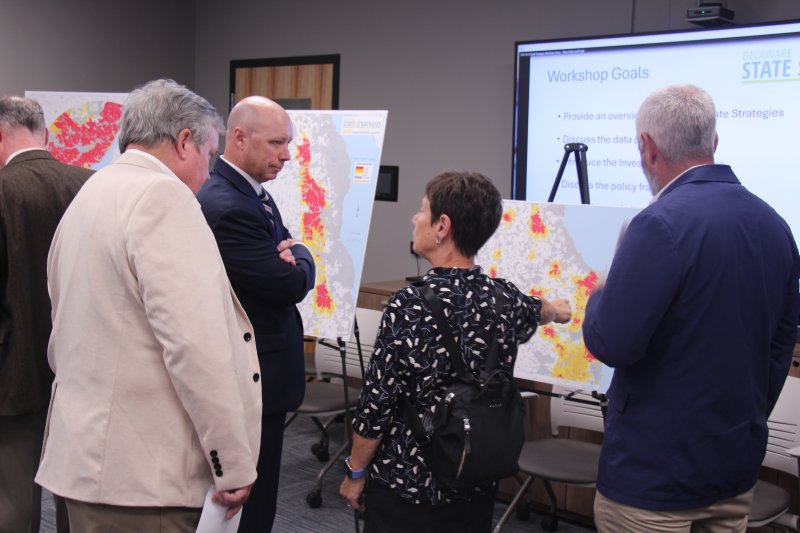Sussex County Council questions draft state planning document
Sussex County Council has questioned the methodology of the draft 2025 Delaware Strategies for State Policies and Spending, suspecting the process may not give the county its fair share of funding.
County Planning & Zoning Director Jamie Whitehouse discussed the maps that are central to the process during an Oct. 7 council meeting. The draft plan is available on the Office of State Planning Coordination website, and the document is expected to be completed in December.
Whitehouse praised the state’s use of technology, which he said provides more detailed data, allowing better analysis than past years. Data on development is used to create locations of investment levels which are used to determine where the state will direct efforts supporting local land use.
“It really is a fantastic tool and a great use of GIS software,” Whitehouse said. “This is a data-driven exercise. These maps aren’t drawn manually by the state planning office; they take a lot of data and they take data layers, and they analyze these using geospatial tools.”
In addition to the statistics that go into the maps, the state plan takes into account the comprehensive plans adopted by each municipality outlining their goals for development and preservation, said David Edgell, director of the Office of State Planning Coordination, Oct. 9.
The state uses investment levels ranging from 1 to 4, with 1 being urban areas and 4 being rural. A state formula to determine which level an area will be in gives a point for proximity to planned growth, services, public safety and utilities, and it takes away a point for areas with natural resources, resiliency, agriculture and forests, limits on growth and miscellaneous protection.
Comparing the state map from five years ago to the current proposal, Whitehouse noted Level 1 areas have grown to reflect development. There is also westward expansion from Route 1 and in Georgetown.
There are also many more Level 2 areas near the coast, in the southeast quadrant of the county and around Ellendale, he said.
County staff has been working with the state since December to check the accuracy of the data that is the basis of the map, Whitehouse said.
The original map did not include the Bayhealth medical center on Route 9, but it was added at the request of the county, Whitehouse said. The draft map does not include a hospital being constructed in Millsboro because it is not open.
“One of my frustrations, and I expressed this to the director, is that this seems to be necessarily backward-looking, not forward-looking,” said Council Vice President John Rieley. “They’ve broken ground for that hospital and yet it’s not included. This is a planning exercise, so you see what’s coming and you should be planning.”
The county asked the state to include the hospital that is under construction, but the state has not yet decided whether to add it, Whitehouse said.
Edgell said his staff is evaluating the plans and schedule for the Millsboro facility to determine if it should be added to the plan. The agency considers information brought to its attention in preparing the plan, he said, citing the Bayhealth facility added at the recommendation of the county.
The state strategies plan is forward looking, as it supports the counties’ own plans, Edgell said.
“We’re not looking back,” he said. “We’re looking at what is on the ground and where we want to invest.”
The county is preparing its official response to the draft plan and the included maps, Lawson said.
The public comment period ended Oct. 10, and Edgell said his office will review all of the information it receives and make necessary changes as it works to finalize the document.
There is a duplication, in some cases, of negative points given for the presence of trees and some wetlands, Whitehouse said.
“It impacts how much the state plans to spend in a particular area, so it has a real impact on resources from the state,” Rieley said.
“It translates to dollars not realized,” Councilman Matt Lloyd added.
“Hence why fairness is important in this process,” Whitehouse said. “It’s because the outcomes of these maps directly determine investment.”
Councilwoman Jane Gruenebaum said the county should be careful not to downplay the importance of environmental protection.
“I think once the levels are changed to make it 3 instead of 4 or 2 instead of 3, it means we have a green light to develop there,” Gruenebaum said. “So, the more you eliminate the guardrails around environmentally sensitive areas …”
Councilman Steve McCarron said the state should be spending more money on infrastructure in Levels 1 and 2, which are already more densely developed, but in Sussex County, most of the spending is in Level 4 rural areas.
“What’s very disappointing to me is when you look at where the congestion is; this is where the state should be spending the most money and it ends up being probably the most congested area,” he said.
Rieley questioned the amount that the Delaware Department of Transportation invests in Sussex County infrastructure.
“Remember when the secretary of DelDOT was here and mentioned that 34% of the state budget’s targeted for Sussex County, which at first glance sounded reasonable,” he said. “Maybe our proper share should have been closer to 40 or 45% because of the pace of growth.”
County Administrator Todd Lawson said the staff is continuing to work to convince the state to improve the data and maps. The state has been open to the points the county has raised, Lawson said.
“As I started with, the map’s only as good as the data that goes into the map,” he said. “We’re hoping that once it goes to the next step and gets endorsed by the committee and eventually gets signed off on, the data will be as good as we can make it.”
Kevin Conlon came to the Cape Gazette with nearly 40 years of newspaper experience since graduating from St. Bonaventure University in New York with a bachelor's degree in mass communication. He reports on Sussex County government and other assignments as needed.
His career spans working as a reporter and editor at daily newspapers in upstate New York, including The Daily Gazette in Schenectady. He comes to the Cape Gazette from the Cortland Standard, where he was an editor for more than 25 years, and in recent years also contributed as a columnist and opinion page writer. He and his staff won regional and state writing awards.
Conlon was relocating to Lewes when he came across an advertisement for a reporter job at the Cape Gazette, and the decision to pursue it paid off. His new position gives him an opportunity to stay in a career that he loves, covering local news for an independently owned newspaper.
Conlon is the father of seven children and grandfather to two young boys. In his spare time, he trains for and competes in triathlons and other races. Now settling into the Cape Region, he is searching out hilly trails and roads with wide shoulders. He is a fan of St. Bonaventure sports, especially rugby and basketball, as well as following the Mets, Steelers and Celtics.
























































